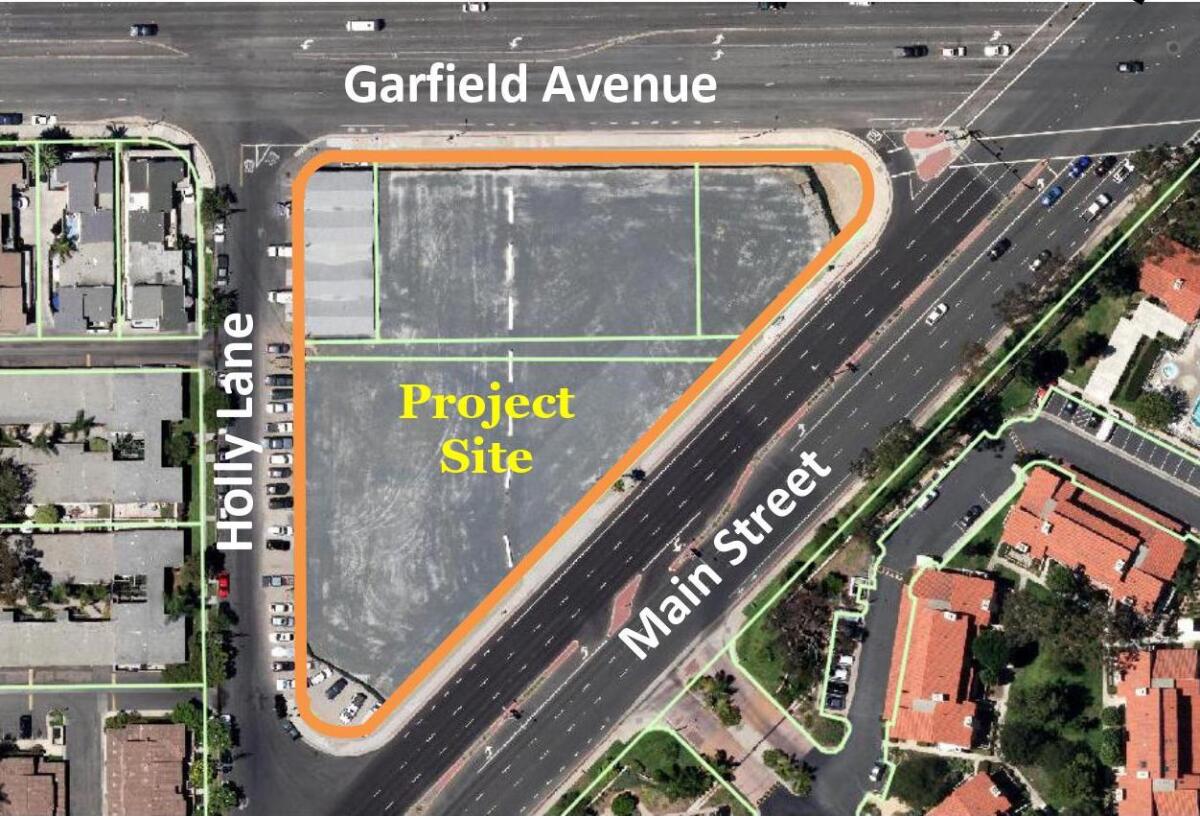Huntington Beach Planning Commission approves zoning change for Holly Triangle townhomes

- Share via
The Huntington Beach Planning Commission on Tuesday unanimously approved a zoning change for a largely unused commercial lot on which nearly three dozen townhomes would be built.
Applicant Bonanni Development plans to develop 35 three-story townhomes, 82 parking spaces and landscaping onto the property dubbed the Holly Triangle at 19070 Holly Lane. The 1.8-net-acre lot, currently vacant except for a glass shop that would be demolished, is bordered by Holly Lane on the west, Garfield Avenue on the north and Main Street running diagonally along the long side of the property.
The property has been zoned commercial since the Holly-Seacliff Specific Plan was adapted in 1992. Ed Mountford, speaking on behalf of Bonanni Development, pressed for the zoning change to allow residential units.
“There’s no commercial development on the property, with the exception of De Guelle Glass in that one corner,” Mountford said. “There’s several reasons for that. Obviously, the small size of the property ... and the shape of the property, triangular, doesn’t really allow for efficient development. Also, where it’s located ... doesn’t provide very good access from either Garfield or Main Street.”
Entry and exit for the proposed townhomes would be strictly from Holly Lane, project planner Alyssa Helper said in a report.
Five of the new condos would have to meet the city’s moderate-income qualifications, as required by the HSSP. Eleven of the 35 condos would have two bedrooms, while the other 24 would be three-bedroom units.
The commissioners discussed at length an oil pipeline that is still active on the property, and four oil wells that need to be reabandoned.
As the fate of the controversial Angel Stadium deal hangs in the balance, affordable housing elsewhere in the once vaunted area is nowhere to be seen.
“Over the years, they’ve actually come up with some very strict standards for how you abandon the well,” Planning Commissioner John Scandura said. “In addition to removing all the equipment, you also remove all the associated pipelines, and I believe you do remove soil contamination. The biggest thing is that they plug the oil well with grout or cement, so other materials can’t seep out of there.”
Scandura, a longtime employee of the California Department of Toxic Substances Control, offered a rebuke of an initial environmental impact report that had no mention of an active oil pipeline, calling it a “gross omission.”
His approval of the zoning change came with three conditions. The first was that all work to assess soil contamination be performed by a contractor approved by the city. Also, if DTSC is unable to oversee remediation, then the applicant will have to seek oversight from the Santa Ana Regional Water Quality Control Board or the Orange County Health Care Agency. He also asked that the project plans be updated to show the active oil pipeline.
“We have to see where that pipeline is on those project plans, to prevent accidentally hitting that pipeline or doing something that would compromise that pipeline,” he said.
Helper assured the commissioners that potential homeowners would be notified of the pipeline.
In the end, the commissioners agreed that the project was standard and that the zoning change was appropriate.
“This property has been vacant for a very long time, so it would be nice to see this piece of property developed, helping to beautify the area,” said Brendon Perkins, chair of the commission.
All the latest on Orange County from Orange County.
Get our free TimesOC newsletter.
You may occasionally receive promotional content from the Daily Pilot.









